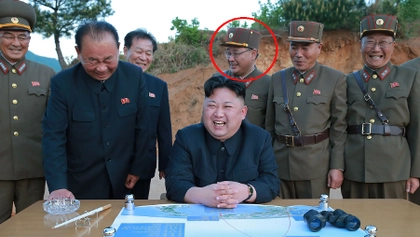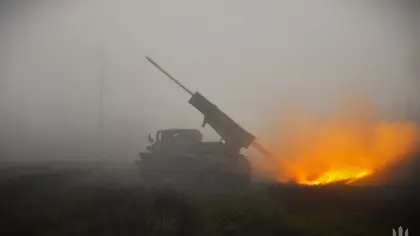Russian Air Force bombers are dropping long-range glider bombs and intensifying air strike missions as part of a campaign to demolish Ukrainian Marines entrenched on the left bank of the Dnipro River, but Kyiv’s forces were holding back Kremlin ground assaults with their own artillery and swarms of civilian drones converted into flying bombs, official and open sources said on Wednesday.
Drone video published by the Russian milblogger Dva Majora on Tuesday showed seven or eight probable aerial bomb explosions striking buildings in the village of Krynky, one of two of Kyiv military toeholds on the eastern side of the Dnipro.
JOIN US ON TELEGRAM
Follow our coverage of the war on the @Kyivpost_official.
According to that account, Russian Su-34 fighter bombers dropped the long-range munitions. The video showed buildings being demolished but it was not clear from the drone video if Ukrainian troops were hurt, or even in the vicinity.
According to a Ukrainian army spokesperson, Kyiv’s air defenses around the bridgeheads lack anti-aircraft systems capable of intercepting Russian aircraft dropping glider bombs as much as 50 km away.
The Russian air force aircraft launched widespread use of glider bombs, a long-range weapon with limited accuracy, but droppable outside the range of Ukrainian defenses, in August.
Ukraine’s Army General Staff (AGS) in a Wednesday morning situation report confirmed the fact of Russian air and artillery strikes targeting Ukrainian troops on the Dnipro left bank, and that Russian aircraft had run 17 air strikes against Ukrainian troops in the Kherson sector over the past 24 hours.

North Korean Ballistic Missile Expert Spotted in Donetsk
The Marines and supporting troops in the bridgeheads were holding and will in the future maintain their positions, and Ukrainian artillery and rocket strikes are systematically destroying Russian artillery and troop concentrations in the vicinity, the Kyiv official statement said.
A Nov. 28 Russian Defense Ministry statement claimed that Moscow’s forces had conducted artillery and air strikes and destroyed Ukrainian troops and military equipment in the Kherson sector and that attacks were continuing. Like the AGS announcement, the official Kremlin statement reported no friendly losses.
The Ukrainian AGS statement singled out soldiers from Russia’s 810th Naval Infantry Brigade, a unit geolocated by Kyiv Post researchers to the Krynky sector, as “refusing to carry out an order to storm the positions of the Defense Forces of Ukraine. The Russian terrorists motivated their refusal on grounds of lack of coordination with artillery, bad weather conditions, and lack of intelligence data.”
A recent Russian naval infantry counterattack planned against the Krynky bridgehead failed, the AGS statement said, because attacking troops wound up crossing Russian minefields whose location was a secret, suffering 50 casualties. Russian attempts to press the second Ukrainian bridgehead, around the village of Pishchanivka, failed due to artillery and mortar strikes hitting the Russians as they approached Ukrainian lines, the statement said.
Some Russian milbloggers in recent reports have reported command and logistics problems causing casualties and preventing effective attacks. @Romanov92, a purported Russian service member deployed to the Kherson sector, on Tuesday in a Telegram statement reported fighters from the 810th Brigade attempted but failed to reduce Ukrainian lines around the Krynky bridgehead because of “poor coordination” with adjacent Russian units, shortages of observation and strike drones and limited artillery support. Wounded Russian soldiers were not immediately evacuated, harming unit morale, the report said.
Ukrainian and Russian military bloggers monitoring fighting around the Dnipro River bridgeheads have been in general agreement for more than a month that conventional forces led by the Marines, one of the Armed Forces of Ukraine’s (AFU) better-trained and more combat-capable formations, are being backed up by unprecedented numbers of civilian drones funded by crowd-sourcing, adapted for military use, and operated largely by volunteers.
The pro-Russia blogger Zhivov Z, citing purported conversations with soldiers serving in Russian forces with the mission of containing the two Kyiv bridgeheads, wrote of the Ukrainian drone swarms: “The main problem is the danger of supplying the front line, and constant attacks by small aircraft (hobby drones). I won’t describe the emotions we feel. There are a lot of them.”
According to open sources, Russia’s southern forces command on Friday attempted to crush the Ukrainian bridgeheads around Krynky and Pishchanivka with conventional ground force assaults led by elements of the 810th Naval Infantry Brigade, the 144th Motor Rifle Brigade, and the 28th Motor Rifle Regiment.
According to Ukrainian reports, the attacks stalled because of heavy Ukrainian artillery fire and drone strikes. Since then accounts of Russian attempts to attack the Ukrainian positions with ground troops have been rare.
The pro-Ukrainian milblogger Nikolaevsky Vanek, among others, on Sunday published video of a purported former 810th Brigade member identifying himself as Mustafa Iskander Ustemovich, in which the Russian military service member confirms he was taken prisoner after being ordered to assault strong Ukrainian positions without proper support, leading to his unit’s being shot up.
Some Russian milbloggers, on Wednesday, were arguing the Kremlin plan was not ground assaults, but attrition, and that overwhelming Russian firepower and attrition would demolish Ukrainian Marine capacity to resist.
The pro-Kremlin Khersonskiy Vestnik wrote on Tuesday: “The enemy (Ukrainian Marines) has no equipment or artillery, except for 80mm mortars. On our side there are motorized rifle formations of the Dnepr group, which have at their disposal cannon and rocket artillery, armored vehicles, and a numerical superiority. Based on the current situation, the Ukrainian Armed Forces have no chance of expanding the occupied bridgehead!”
The first Marine crossings of the Dnipro River, Ukraine’s biggest waterway, took place in mid-October. According to most reports, currently between 300-500 Ukrainian troops hold positions on the left bank of the river.
You can also highlight the text and press Ctrl + Enter









